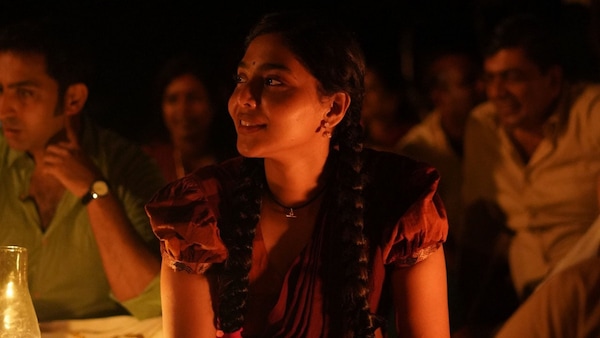Exclusive! Aishwarya Lekshmi: In Kumari, we’ve been able to give equal space to all characters
Aishwarya Lekshmi talks to us about her latest fantasy horror-thriller Kumari and about learning from her co-stars

Last Updated: 05.14 PM, Oct 27, 2022
It’s been a whirlwind month for Malayalam actress Aishwarya Lekshmi, shuttling between industries for the promotions of her films – Ammu and Kumari – both of which has her in the titular role. Kumari is also special as it has her as a co-producer, who is not just invested in it for the money but also for the experience that the horror-fantasy thriller will provide to the audience when it hits theatres on October 28.
In an exclusive interview ahead of the release of the movie, directed by Nirmal Sahadev, Aishwarya Lekshmi tells OTTplay about her initial apprehensions, her major takeaways as well as the experience of shooting the movie with her talented co-stars such as Shine Tom Chacko, Swasika Vijay and Surabhi Lakshmi.
It’s been a long time since Malayalam has had such a film, but considering that it’s made by a young team, it sort of guarantees a fresh spin on the genre. Is that so?
When Nirmal first narrated this script to me, it was obviously fascinating but I didn’t understand how he could pull it off in a limited budget as a female-centric film. I was sure that if we made it on a small budget, we would end up compromising on the quality of the film. So, while I wanted to be part of the film, I was skeptical about how it was going to look. I said yes because I am a greedy actress and I didn’t want the role to go to anyone else.
When I expressed my concern on the quality, he told me about the technicians who are part of the film and that Prithviraj Productions will also be associated with it. When such a person is associated with the film, then you know that it will have a certain quality.
One thing that stands out is the female cast of the film – be it you, Surabhi Lakshmi, Tanvi Ram or Swasika Vijay. Are all of them playing characters that are vital to the movie?
Yes, it also stands out in another aspect – something that we have all been preaching for a long time. We have been able to give equal space to women characters in the film. Kumari, as a character, is more of an observer. In the first few days of the shoot, the dialogues I had were, ‘What’s that?’ ‘And then?’ Kumari was understanding the world based on the story that Swasika’s character was narrating. All of them form important elements of Kumari’s world. There is space for every character to perform - male or female. And every actor has done a fabulous job and the world of Kumari is believable more so because of them.
How much could you relate to the story of Kumari and her world, based on the folklore that you have probably heard growing up?
I have heard a lot of stories when I was young but this wasn’t similar to those. The stories that I heard were probably closer to the tales of temples. For this, the makers have taken references from Vadakkan Aithihyamala.
Tell us about working with actors such as Shine Tom Chacko and Surabhi Lakshmi, who are chameleons on screen.
I think passionate is the word we should use for Shine. He is always in character. Yesterday, we had a video call with him because we were all missing him for the promotions as he was busy with shoots. I haven’t seen him take rest for a single day because he feels overworked. He is the happiest when he is in front of the camera. I also think he’s the easiest co-star I have worked with because I didn’t need any filter while talking to him. I could tell him what I thought; if he was doing something that was not working for me, I was comfortable enough with him to point that out. What he did with the information was totally up to him, but I could tell him that.
So, there was a camaraderie. He would ask me why I was doing certain things a certain way. How we used to work was that after reading the script, we could discuss how we could perform the scene. It was a different type of filming because usually you would be told what to say and when. It was something new for me and I think Shine prospered in Nirmal’s direction because he was given free reign; he used his entire body to perform.
Similarly, Surabhi is an extremely passionate actor. She is someone who acts to survive and that’s how he approaches her roles. Swasika too is a brilliant artiste, who uses her eyes to enact. I could notice all this because my character is someone who observes all of them from a corner. And I could learn a lot from all of them.
The films that you have been selecting lately – be it Archana 31 Not Out, Ammu or Kumari – involve transformational journeys of your characters. Ammu was shot linearly, but how was the process for Kumari?
I think Kumari was one of the easiest films I have done as an actor. I didn’t do it for the scope of acting; I did it for the experience that the movie would provide for the audience, from my imagination. And I am proud to say that whenever I see the various versions of the film, it’s become so much bigger than I imagined. From the beginning of the shoot based on the art department’s work to now watching the movie after DI, colouring and Jakes Bejoy’s music, it’s a mood piece; the entire film will make for a great experience. Whether people will like it or not, we will find out only tomorrow when the movie releases.
Is the movie set in the current era?
No. It shows two timelines – one that is twelve generations ago and Kumari’s present, which we haven’t specified but it’s around the late 70s and early 80s. We have taken a lot of cinematic liberties, and because it’s an imaginary world, I don’t think it would be too much of a concern.
Subscribe to our newsletter for top content, delivered fast.

